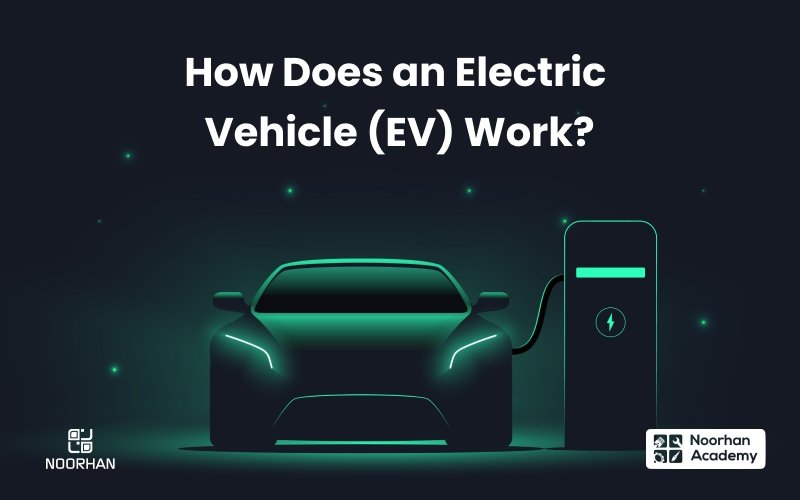-
What does EV actually mean?What does EV actually mean?
-
How does an Electric Vehicle (EV) Work?How does an Electric Vehicle (EV) Work?
-
Difference between Electric Motor and Internal Combustion EngineDifference between Electric Motor and Internal Combustion Engine
-
Important Parts of Electric VehicleImportant Parts of Electric Vehicle
-
Types of Electric VehiclesTypes of Electric Vehicles
-
Advantages of Electric VehicleAdvantages of Electric Vehicle
Electric vehicles are extremely popular these days. Major automakers are having big plans for electrical vehicles.
When we look at the plans of major automakers, it could be safely predicted that most of the vehicles on the road, by 2040 will be electric vehicles.
What does EV actually mean?
Electric Vehicle or EV in short runs on electricity. So they don’t need Internal Combustion Engine (IC engines). This results in low emissions and hence in less pollution, which is good for the environment.
Electric cars are powered by batteries. They are not powered by traditional methods like gasoline or petrol or diesel. They are operated on an electric motor, which works on a battery.
Let's talk about how does an Electric Vehicle (EV) Work.
Electric vehicles work on the electric motor. There is a power controller attached to the electric motor of the EV. When the driver of an electric vehicle accelerates or decreases the speed of the vehicle, this information is passed on to the controller and then, the controller regulates the power and passes it on to the electric motor. The electric motor is completely operated by a controller.
The electric battery attached to the vehicle is rechargeable. You can recharge these batteries with the normal electricity in any household or with the charging points provided specifically for EVs.
Electric vehicles are like automated cars. They have two different modes: forward and reverse.
Difference between Electric Motor and Internal Combustion Engine
The electric motor and the Internal Combustion engine are doing the same thing creating a rotatory motion that rotates the wheels of the car.
The important difference is that the energy operating them is different – one uses electric energy other uses thermal energy.
So if you understand this difference, it will help you understand how does an electric vehicle work
Important Parts of Electric Vehicle
Recommended read: The Ultimate Guide To Car Spare Parts
Electric Traction Motor
The Electric traction motor is the part of the vehicle which uses the electricity and creates the rotatory motion used for transmission of the Wheels of the vehicle. Some vehicles use a motor generator. The motor-generator performs both, drives the vehicle and generates the electricity. The most commonly used electric motor is the brushless DC motor.Power Inverter
The power inverter changes the electric DC (Direct Current) into AC (Alternating Current). This AC is used by the electric motor to run the vehicle. This also has the function of changing the AC into DC and recharging the battery. This is why the type of inverter used is of the bidirectional category.Traction Battery Pack
The work of the battery pack is to store electricity in the form of direct current. When it gets a signal from the controller, the battery will transmit the DC electric current.Power Electronics Controller
The power electronic converter is the combination of inverter and converter. This recharges the battery when there is braking of the electric vehicle. The kinetic energy is used to charge the vehicle. Some of the vehicles use electric AC controllers.Battery
The electric battery provides the power to power the different parts of the electric vehicle.Recommended read: 10 Useful Tips To Extend The Life Of Your Car Battery
Charging Port
The charging port allows the vehicle to connect to an external supply.DC/DC Converter
Yes, you read it right, it’s not an AC to DC or a Dc to AC converter. Unlike an inverter, it’s something different. This device converts the high voltage DC power into low voltage DC which runs the different accessories of the electric vehicle. And, in recharging the auxiliary battery.Charger
The charger is the battery charging device. It uses the electricity from the outside sources and transfers it to the battery. There are two types of electric vehicles:- On-board charger: These are inside the car, and use the internal energy to charge the battery.
- Off-Board charger: These are the external chargers
Transmission
Transmission parts of the electric vehicle are responsible for transforming the rotatory power from the electric motor to the wheels of the car and drive and braking system.Recommended read: What Is Meant By A Power Train In Your Car?
Types of Electric Vehicles
There are 4 types of Electric Vehicles:
- Battery Electric Vehicle (BEV)
- Plug-in Hybrid Electric Vehicle (PHEV)
- Hybrid Electric Vehicle (HEV) and
- Fuel Cell Electric Vehicle
Battery Electric Vehicle (BEV)
Battery electric vehicles are also called all-electric vehicles – they drives entirely on the electric battery. The battery provides a probe to one or more electric motors of the car and drives the vehicle. Some examples of BEVs are Tesla Model 3, Volkswagen e-Golf, Peugeot e-208, Mini Electric, MG ZS EV, Tesla Model Y, Nissan Leaf, and Renault Zoe.Battery Electric Vehicle (BEV)
Battery electric vehicles are also called all-electric vehicles – they drives entirely on the electric battery. The battery provides a probe to one or more electric motors of the car and drives the vehicle. Some examples of BEVs are Tesla Model 3, Volkswagen e-Golf, Peugeot e-208, Mini Electric, MG ZS EV, Tesla Model Y, Nissan Leaf, and Renault Zoe.Hybrid Electric Vehicle (HEV)
Hybrid electric vehicles are also called standard hybrid or parallel hybrid vehicles – they have both electric motors and internal combustion engines. In this kind of vehicle, the car gets power for IC engines from fuels like gasoline, diesel, or petrol, etc. and the motor gets power from the battery. The IC engine and electric motor together run the transmission, which drives the vehicles. The battery of the hybrid electric vehicles can only be charged with the power from the IC engine, or the wheels of the car, or the combination of both. There is no charging port to charge the battery from outside sources. Some examples of HEV are Honda CR-Z, Chevrolet Tahoe Hybrid, Toyota Prius and Toyota Camry Hybrid, Ford C-Max, and Kia Optima Hybrid.Plug-in Hybrid Electric Vehicle (PHEV)
Plug-in Hybrid Electric Vehicle has both IC engine and electric motor. These cars provide an option for either of the modes. They can be powered by gasoline, diesel, or petrol, and by a rechargeable battery. You can charge the vehicle from outside sources. These cars have two different modes: all-electric mode or hybrid mode. In the hybrid mode both the electric motor and IC engine drive the car. Some Examples of PHEV are The Chevy Volt, Audi A3 e-Tron, Ford C-MAX Energi, and Mercedes Benz C350e.Fuel Cell Electric Vehicle
Fuel cell electric vehicles are also called zero-emission electric vehicles. In these kinds of EVs, fuel cell technology is used to drive the vehicle. The fuel cells generate the electricity required to run the battery. The chemical energy is converted to electrical energy. Some examples of fuel cell EVs are Hyundai ix35 FCEV, Toyota Mirai, Hyundai Tucson, and Honda Clarity Fuel Cell.Advantages of Electric Vehicle
Electric Vehicles definitely have more advantages than traditional vehicles with Internal combustion engines.
We have already shared this in our previous blog (Future plans for Electric Vehicles by Major Automakers).
This is a quick brief about the advantages of electric vehicles.
Here are the advantages of electric vehicles:
- No Emissions. Low Pollution
- Low Maintenance
- Low Running Costs
- Performance
For further reference: Electric cars Advantages and disadvantages
No Emissions and Low Pollution
The emissions in an electric vehicle are much lower. Hence the negative impact of the vehicle on the environment is reduced. Switching to electric vehicles means less pollution.Low Maintenance
When a traditional fuel system is removed from the equation, the maintenance required for your car is drastically reduced. With EVs, the debris accumulated is much less and the problems are reduced significantly.Low Running Cost
With Petrol, diesel, and other fuels, the prices keep on increasing. Hence the cost of running a traditional vehicle is much higher compared to an electric vehicle. The Running cost of EVs is much lower if calculated.Performance
The EVs make driving a fun experience because the motor reacts quickly. They are more responsive than vehicles that run on internal combustion engines. And, they provide good torque. The acceleration in well-developed cars is quite good. The Tesla Model S could go from 0-60mph in 2.5 seconds.Wrap Up: How does an Electric Vehicle work
So we just discussed the working of electric vehicles (EV).
In a nutshell. Electric vehicles are powered by electricity. The main driving power of the electric vehicle comes from the rechargeable battery. Soon we could safely predict that we would see more electric vehicles and less traditional Internal combustion engines.






